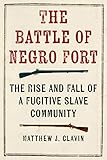The Battle of Negro Fort : The Rise and Fall of a Fugitive Slave Community / Matthew J. Clavin.
Material type: TextPublisher: New York, NY : New York University Press, [2019]Copyright date: ©2019Description: 1 online resourceContent type:
TextPublisher: New York, NY : New York University Press, [2019]Copyright date: ©2019Description: 1 online resourceContent type: - 9781479837335
- 9781479868575
- HISTORY / United States / Revolutionary Period (1775-1800)
- Andrew Jackson
- Army
- Bahamas
- Battle of New Orleans
- Benjamin Hawkins
- Bowlegs
- Choctaws
- Creek Indians
- Creeks
- Duncan Clinch
- Edmund Gaines
- Edward Nicolls
- Florida
- George Woodbine
- John Brown
- Joshua Giddings
- Native Americans
- Navy
- Nero
- Prospect Bluff
- Red Sticks
- Seminole War
- Seminoles
- Slave Power
- War of 1812
- William Jay
- William Lloyd Garrison
- William McIntosh
- congressional investigation
- expansion
- interracial alliance
- maroon
- maroons
- popular history
- slavery
- online - DeGruyter
| Item type | Current library | Call number | URL | Status | Notes | Barcode | |
|---|---|---|---|---|---|---|---|
 eBook
eBook
|
Biblioteca "Angelicum" Pont. Univ. S.Tommaso d'Aquino Nuvola online | online - DeGruyter (Browse shelf(Opens below)) | Online access | Not for loan (Accesso limitato) | Accesso per gli utenti autorizzati / Access for authorized users | (dgr)9781479868575 |
restricted access online access with authorization star
http://purl.org/coar/access_right/c_16ec
The dramatic story of the United States' destruction of a free and independent community of fugitive slaves in Spanish Florida In the aftermath of the War of 1812, Major General Andrew Jackson ordered a joint United States army-navy expedition into Spanish Florida to destroy a free and independent community of fugitive slaves. The result was the Battle of Negro Fort, a brutal conflict among hundreds of American troops, Indian warriors, and black rebels that culminated in the death or re-enslavement of nearly all of the fort's inhabitants. By eliminating this refuge for fugitive slaves, the United States government closed an escape valve that African Americans had utilized for generations. At the same time, it intensified the subjugation of southern Native Americans, including the Creeks, Choctaws, and Seminoles. Still, the battle was significant for another reason as well. During its existence, Negro Fort was a powerful symbol of black freedom that subverted the racist foundations of an expanding American slave society. Its destruction reinforced the nation's growing commitment to slavery, while illuminating the extent to which ambivalence over the institution had disappeared since the nation's founding. Indeed, four decades after declaring that all men were created equal, the United States destroyed a fugitive slave community in a foreign territory for the first and only time in its history, which accelerated America's transformation into a white republic. The Battle of Negro Fort places the violent expansion of slavery where it belongs, at the center of the history of the early American republic.
Mode of access: Internet via World Wide Web.
In English.
Description based on online resource; title from PDF title page (publisher's Web site, viewed 01. Nov 2023)


